Space Marine Intercession Teams arrived in August 2022, shortly before Into the Dark and the Annual threw another four teams into the mix along with a new mode of play. This was the biggest shake up the game had had since launch, and Into the Dark, the additional rules like Guard and the boards used for Into the Dark created a second meta in Kill Team games, as some teams (like Gellarpox) do so much better on Into The Dark maps with the shorter engagement ranges and choke points and some teams struggle, like Kroot, who benefit from hugging cover and denser maps like Octarius.
What happened was that Intercessors became the most popular Kill Team in the world (in retrospect this should have been the obvious thing to happen) and Phobos got pushed to the side. Intercessors became the ultimate beginner faction, as everyone had some of them knocking around, and if you wanted to go crazy for competitive play then a sprue of Intercessors and a sprue of Assault Intercessors was still a pretty full roster.
The result of this is that a lot of players not playing Intercessors have put a lot of thought into how to beat Intercessors because they are a good, flexible team that is composed of tough models with good damage output that is easy to play in the same way Custodes are. Each operative can take a punch and punch back pretty hard, so you don’t need to operate in a web of supporting interactions of the sort that Novitiates or Heirotic Circles need, where you generate your Faith points with certain models for other models to use, or you stay in range of your space cats to get access to Resurrection etc. This led to Intercessor teams being incredibly good, to the point where they received a small nerf in the Q1 2023 balance dataslate.
So let’s get into the detail.
Intercession Squad Kill Teams
Intercession Squad teams are basically made up of regular Intercessors and Assault Intercessors; there are sadly no Hellblaster options nor heavy intercessors to give the team a bit more punch.
Team Structure
An Intercession Squad is a single fire team consisting of one Sergeant – either an Intercessor or Assault Intercessor, and a mix of 5 additional operatives chosen from a list of:
- Assault Intercessor Warrior
- Assault Intercessor Grenadier
- Intercessor Warrior
- Intercessor Gunner
You can only have one each of a Grenadier and a Gunner, and the Gunner comes with an auxiliary grenade launcher attached to their bolt rifle.
Strengths
- Amazing Statlines – Intercession Squad marines have solid statlines and an extra wound over their Compendium counterparts. Like most marine operatives, their biggest advantage is that they come with 3 APL.
- Durability – With a 3+ save and 14 wounds apiece (and 15 on your leader), Intercession Squads offer a fair amount of durability for a 6-model team. They’re one of the toughest units in the game.
- Strong Fundamentals – While you only have basic weapons with the exception of the one shot per turn auxiliary grenade launcher, those basic weapons are pretty good. Depending on your opponent you might go with Ceaseless Assault Bolt Rifles or P1 Bolt Rifles (I would say that having a Heavy basic weapon has so many problems for moving around the board that I wouldn’t take it). Similarly a P1 pistol on Assault Intercessors is decent enough for a melee model and six inch range is fine in the Gallowdark.
- Efficient: Probably the word that best defines the intercessors is that they are efficient. Unlike their brothers on the Phobos kill team Intercessors have access to re-rolls, plus with some tactics they are able to hit on a 3+ regardless of whether they wounded, performing Overwatch, or standing guard.
Weaknesses
- Taking on Heavy Targets – Intercessor weapons are OK but not amazing. As with Phobos teams, your play is going to rely more on volume than quality – you don’t really have any big ranged weapons to punch through heavy armor, and your Leader is going to have to do the heavy lifting in melee with a power fist or thunder hammer. You have limited access to AP – a Krak grenade on the grenadier, the grenade launcher on the gunner and the plasma pistol on the sergeant if you take it.
- Board Control – As with all elite teams you only have so many models to contest objectives/kill stuff/do stuff, and your team degrades much faster as you lose models. Guard can lose six guys and still have plenty to get stuff done, you lose two or three and you’ve got problems. Your lack of activations is also a problem, and without a method to pass activations you’re especially vulnerable during the first turning point to taking damage without the chance to react or respond.
- Unique Actions – Following the trend we saw with Phobos teams, Intercession Squad operatives don’t really have any unique actions, making it difficult for them to take full advantage of having 3 APL. Unique actions are a great way to bring character to a team, and the sergeants not having a command related unique action (especially if they had different ones) makes them a little less special, simply being a stock model with +1 wound, better hit rolls and access to power weapons.
- Flexibility: Without being able to perform mission actions you can suffer a lot, especially in missions A and B.
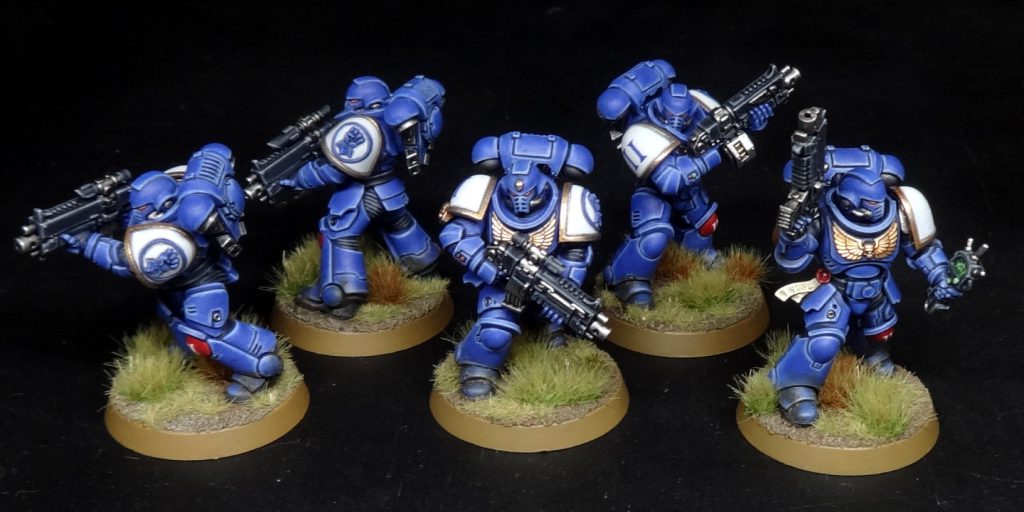
Abilities
To make up for being relatively tame on the composition side, Intercession Squad kill teams get a doozy of a team ability in Chapter Tactics, which lets you customize the abilities of your team. Note that your Chapter Tactics are chosen at the roster level, and so you’ll only have one set for a given kill team (they won’t be changed between games unless you use the Adaptive Tactics ploy).
Chapter Tactics
There are four categories of Chapter Tactic, each with three tactics. When building your roster, you can choose two tactics for your team to have. Note that the categories only matter for other rules – you aren’t limited to one per or anything. There’s also no guidance on how different chapters use these, so you’re welcome to just pick whichever.
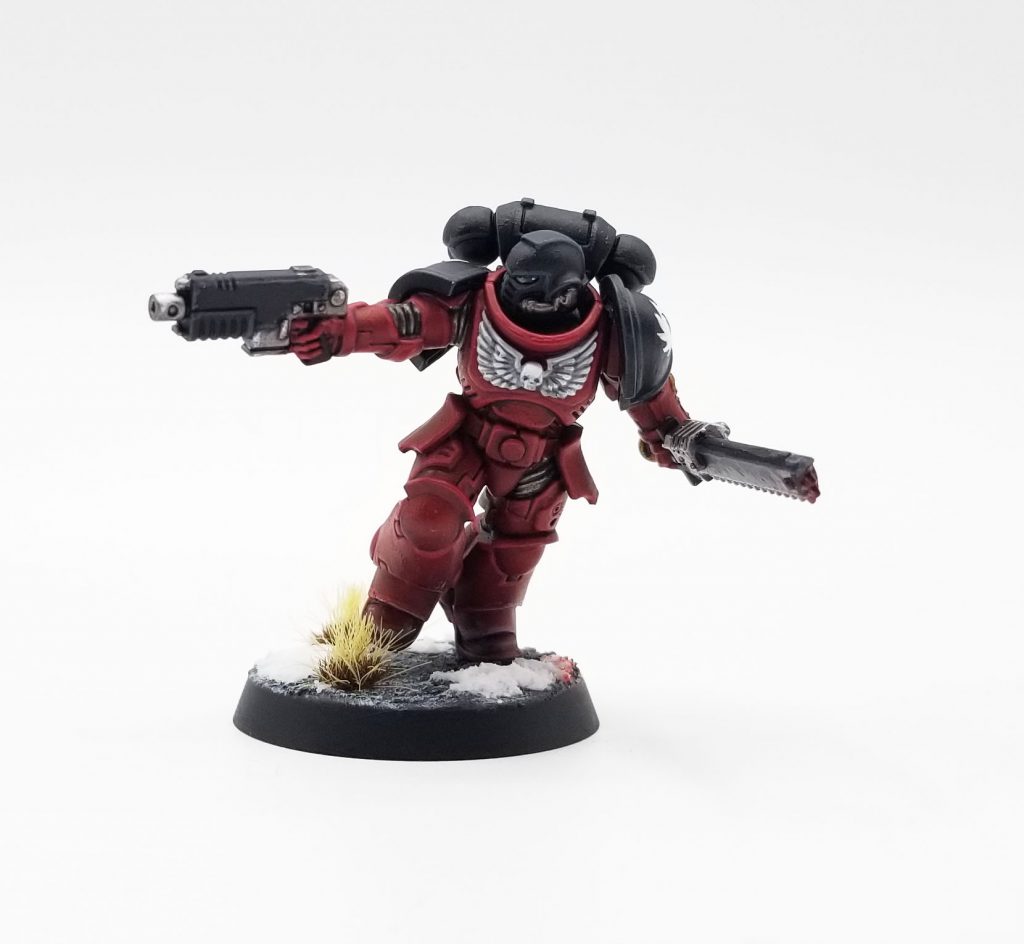
Martial Zealotry
These are the melee traits.
- Aggressive – Each time this operative fights in combat in an activation in which it Charged, its melee weapons gain the Rending critical hit rule for that combat. This is a weaker option simply because a majority of your damage is likely to come from ranged attacks, while Assault Intercessors aren’t bad; this tactic should be avoided unless they make up a majority of your team. Since tactics are chosen at roster creation choosing this tactic means you have greatly narrowed your options.
- Dueller – Each time this operative fights in combat, in the Resolve Successful hits step of the combat, each time it parries with a critical hit, you can discard an additional normal hit of your opponent’s. This tactic pairs really well with Aggressive as a single crit will ensure you can easily parry away your opponents dice pool, but it suffers the above’s same issues, it’s limiting.
- Rapid – Add ▲ to this operative’s movement characteristic. This means you’re moving 7” (not 9”) with the operative, but it does mean you can get 9” charges, which is pretty huge. Speed kills, you’re basically getting the Vanguard ploy from the Phobos team for free, you can never go wrong with this choice.
Tactical Evasion
These traits are all about taking defensive action and keeping your models on the table and out of hairy situations.
- Raider: This operative can charge while within Engagement Range of an enemy operative. Also, every time this operative does a Normal move, it can move within Engagement Range of enemy operatives (but cannot finish its move there). This means control zones can be ignored or at least mitigated, and opens up a lot of possibilities. It also means the enemy can’t pin you with an expendable model, you can charge out at a juicier target but it has to be a charge, for retreating and shooting you want Mobile.
- Stealthy: Each time a shooting attack is made against this operative, in the roll defense dice step of that attack, before you roll your dice, if it’s in cover and more than ⬟ from the active operative, you can either retain an additional dice as a successful normal save as a result of cover, or retain one die as a critical save instead of a normal save as a result of cover. This is an excellent tactic, being able to auto retain die is an excellent way to ensure you survive enemy attacks, however if your opponent has the No Cover special rule this tactic is wasted.
- Mobile: This operative can perform the Fall Back action for one less AP (to a minimum of 1). Different to Raider and useful as it is not uncommon for horde/melee teams to purposefully charge enemy operatives they outnumber in order to tie them up in following Turning Points, especially useful for standard Intercessors who can then fallback, AND shoot twice. If a Harlequin charges you and doesn’t kill you, then stepping back and shooting them twice in the head is exactly what you want to do.
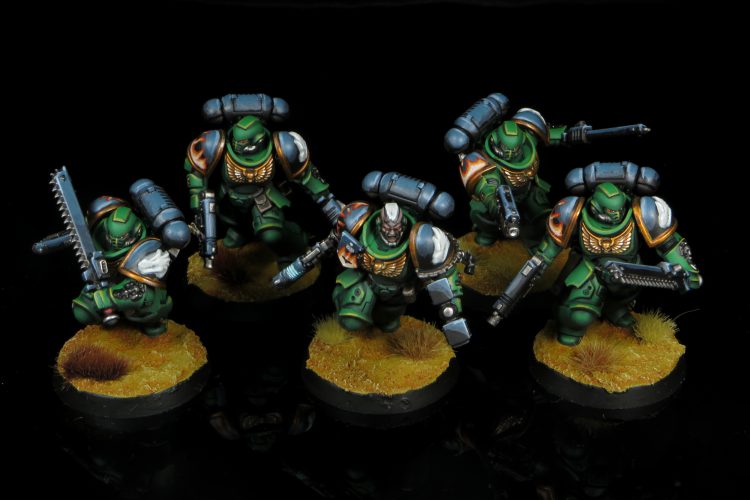
Gene-wrought Resilience
These all make your operatives tougher to kill.
- Unyielding: Add 1 to this operative’s Wounds characteristic. While extra wounds aren’t bad this is easily one of the worst tactics. Odds are you will not notice the one extra wound on an operative that has 14, and almost any other tactic should be taken over this as it is only useful against damage 2 or 7 weapons. Any other damage profile is still going to incapacitate you in the same number of hits. Durable and Hardy are much more useful.
- Durable: Each time your operatives are shot at or hit in melee, a single critical hit does 1 less damage to this operative, to a minimum of 3. Even with the changes to this in the last dataslate – adding a wound floor and reducing it to once per activation, this is still one of the better tactics which helps Intercessors act like the heavy tanks they are. Given criticals are also likely to be the hits that leak through your 3+ save, this effectively gives you 1-2 extra wounds over the course of a game.
- Hardy: Each time a shooting attack is made against this operative, in the roll defense dice step of that shooting attack, retained defense dice results of 5+ are critical saves (instead of 6+). Now this is what you want. Critical hits can really swing encounters, and basically doubling your odds of making a critical save is a game-changer. As far as I know this ability is currently unique to Intercessors.
Discipline of Iron
Despite the name, these don’t make your guys any tougher; instead they’re the shooting buffs.
- Accurate: Each time this operative makes a shooting attack with a bolt weapon, in the roll attack dice step, if you retain any critical hits that weapon gains the No Cover special rule for the attack. Very useful for pushing damage through, especially against teams that rely on cover. You can use the Vengeance Scope on Bolt Rifles to really get maximum mileage out of this.
- Methodical: You can ignore any or all modifiers to the BS and WS of this operative’s weapons. Taking this will drastically reduce your need for the They Shall Know No Fear ploy, and even has the added benefit of making your Overwatch attacks the same as standard attacks. Not a bad choice, especially if you’re leaning heavily into Intercessors.
- Deadly Sharpshooter: For this operative’s bolt weapon, decrease their critical damage by 1 and they get the MW1 critical hit rule. The weakest of the Discipline of Iron, if this had been a straight addition of MW1 it might see play, but the requirement to reduce your crit damage to compensate makes this a minor improvement. Go ahead and skip this one.
Which Traits to Use
While there are four categories of Trait to choose from, some of these just stand out way more than the others. Here are the best of the bunch:
- Durable: Even with the changes in the Q1 Dataslate this is one of the best options for the team, helping turn your Intercessors into tanks.
- Methodical: Taking this will drastically reduce your need for the They Shall Know No Fear ploy, and even has the added benefit of making your Overwatch attacks the same as standard attacks. Not a bad choice, especially if you’re leaning heavily into Intercessors. This is probably the best Chapter tactic since it allows you to save precious CP as you won’t be using TSKNF nearly as often. It also lets you be super efficient when you use Guard or Overwatch.
- Rapid – The underappreciated third wheel of the bunch. If either of the other two top chapter tactics chapters gets nerfed you most probably should tinker with this one. It gives you much more threat range on the charge or allows you to Move + Dash + Shoot your enemies in the face.
The competitive play is to take Methodical + Durable for pretty much every situation, though there’s a case to be made for taking Rapid over Methodical if you’re on open terrain for your games but even then it’s suboptimal when you consider the CP you save taking Methodical instead.
Shock Assault
All of the Assault Intercessors have this ability, which lets them perform two Fight actions each activation. On the whole this is much less useful than Bolter Discipline, but can be a really nasty ability when combined with the Raider Chapter Tactic or simply multi-charging.
Bolter Discipline
Your non-Assault Intercessors have this ability, which lets them perform two Shoot actions each as long as one is conducted with a bolt weapon. This means you can bolter and grenade your enemies with your gunner.
The Three Sacred Types of Bolter
Our bolter comes in a three flavors:
- The Autobolt rifle is incredibly efficient, giving you the Ceaseless rule but without access to AP. It’s perfect for eliminating enemy GEC.
- The beauty of the bolter rifle is that you can equip it with the sights (remember that these cannot be attached to the autobolt rifle), adding Lethal 5+ to its P1 attribute to give it a strong kick that improves your squad’s AP output substantially.
- Then there’s the Stalker bolt rifle, which burdens you with Heavy on a team where we want to be always on the move. So despite having AP1 it will pretty much never be taken into consideration.
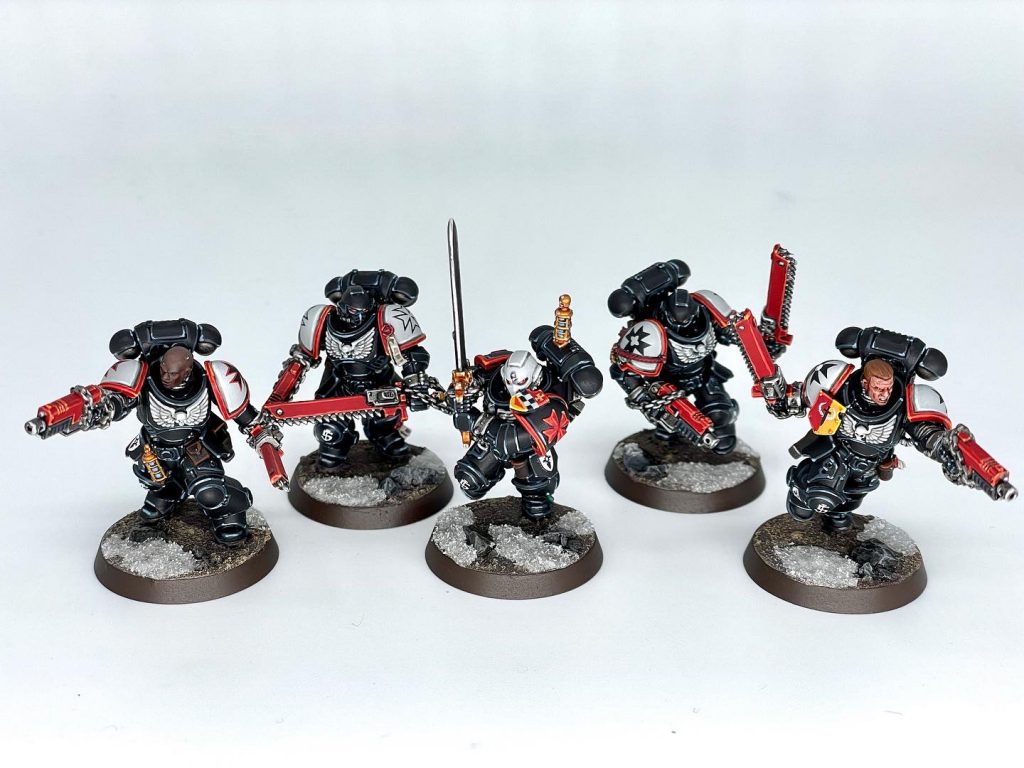
Operatives
With a limited number of specialist operatives your team will almost certainly consist of an Assault Intercessor Sergeant, an Assault Intercessor Grenadier, an Intercessor Gunner and three Intercessors/Assault Intercessors depending on preference. The mix is where it gets important, because it determines whether you are a shooty team with a couple of melee operatives, a melee team with a shooty operative or two, or if you try to perfectly balance it.

Assault Intercessor Sergeant
A slightly buffer Intercessor with access to a selection of pistol weapons and power weapons. However, taking plasma pistols lock you into taking a chainsword, so if you need power weapons you are leaving plasma at home, which isn’t really worth it. The only AP2 weapon on your roster is really where this guy brings value to the table so if you’re taking him, it’s with the plasma pistol.
In competitive rosters the only assault intercessor sergeant taken is the plasma pistol and chainsword, as it gives access to another AP weapon, and against a lot of opponents a 4/5 chainsword hitting on 2+ on 5 dice is functionally about the same as power weapons. Wound 7/8/9 models will die just as fast. If you want to take a power weapon you are better taking it on an Intercessor Sergeant.

Intercessor Sergeant
The more standard Intercessor leader option, the Intercessor Sergeant allows you to take a bolt rifle or its Auto/Stalker variants along with a power fist, power weapon, or thunder hammer, but the tradeoff is that you’re -1 attack and -1 WS when it comes to using the melee weapons.
The strength of this model is the 2+ to hit bolter, combined with Reclusiam-Blessed Bolts and a Vengeance Class Scope if the model takes a bolt rifle, which basically gives your sergeant a sawn off heavy bolter that hits on 2+. Combined with a power weapon or other powerful melee weapon this is model is the Rambo of the Intercession team. That’s just a better option than giving him a fist or hammer.
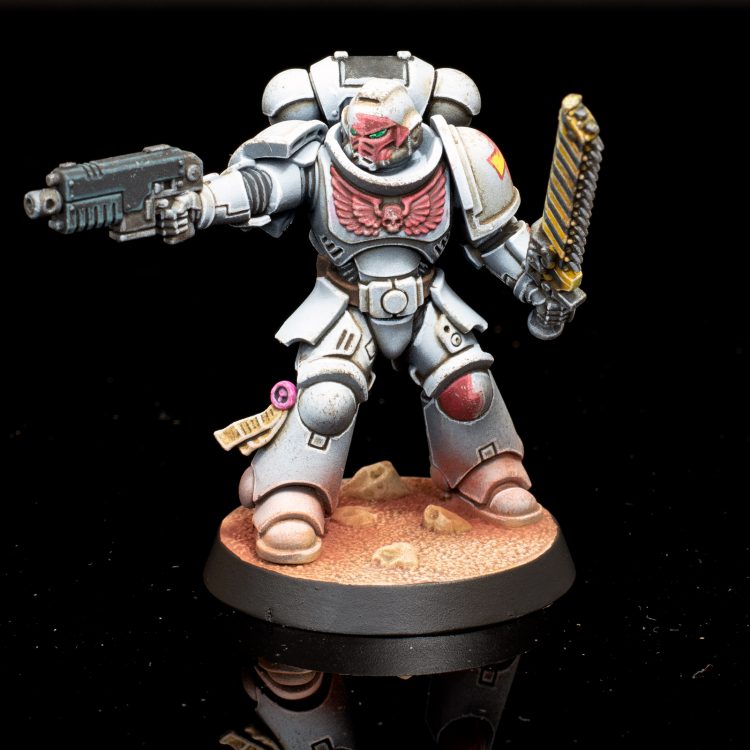
Assault Intercessor Warrior
The chad space marine to kick standard humans around the board, the Assault Intercessor can just straight Fight twice as an ability, and has a 5 dice 3+ 4/5 Chainsword to do it with, which is going to mow through anything with eight wounds or less in two hits. These guys make fantastic front line models, plus they can hit twice without spending CP. Be careful, however – even with 5 attacks we will often find ourselves getting only two wounds in and we will not be able to kill a guardsman. In addition, we must also understand that going to combat means losing wounds, while we only have a 85 wounds in the entire field to work with. Be careful with where and when you get into melee combat.
Assault Intercessor Grenadier
This guy is an auto-take for the team. Comes with both grenade types on the Assault Intercessor profile for free, but locks you out of buying any more grenades after the FAQ. As a grenadier model having 3+ armor, 14 wounds, 3APL and good melee and decent short range shooting, this is actually a really strong grenadier. There’s a lot you can do with this model, and intercessor survivability helps you do it. You always want one of these on the battlefield.
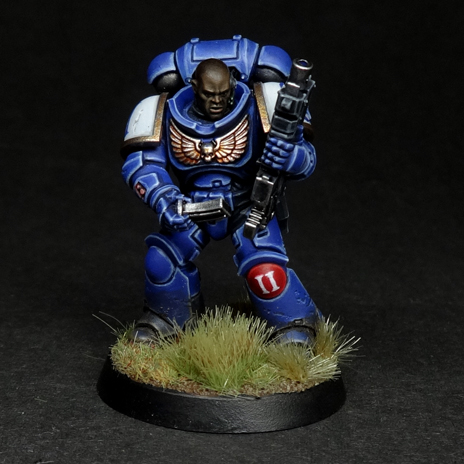
Intercessor Warrior
One of the best Warriors in the game. You always want these equipped with bolt rifles and whenever you put a bolt rifle on one you’ll give him a scope. With Lethal 5+, P1, and access to re-rolls you have a weapon that will absolutely have your enemies knowing fear.
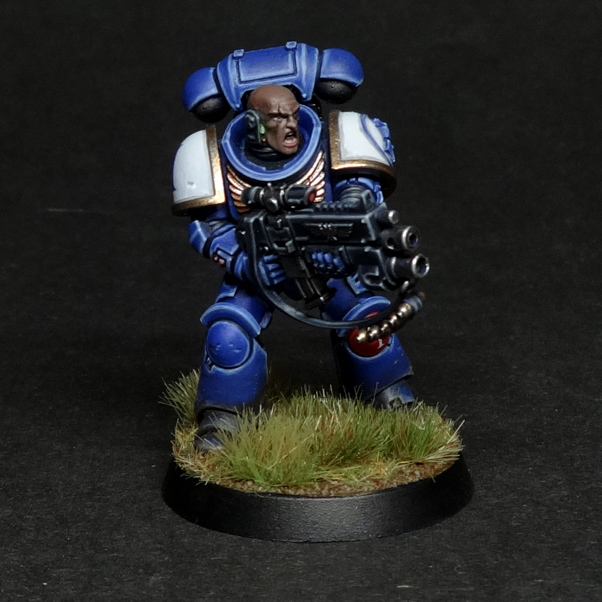
Intercessor Gunner
A must-take for being a model with long range blast and long range AP. Not as good as having a heavy bolter, but every little bit helps. Having two shots, one with the bolter profile and one with the grenade launcher lets you break up enemy clumping (frag) or knock wounds off something big (krak) and then clean up with your bolter shot – and here we always want the autobolter. This is also the operative you’ll want to give the Auspex to, if you’re planning to take it. You can spend 1 AP to use it to climb a building and shoot a sneaky grenade at an unwary group of enemies on open terrain maps.
Ploys
There are eight ploys, four and four. With Bolter Discipline and Shock Assault becoming abilities, we get all new ploys instead.
Strategic Ploys
There are three Doctrine ploys, you can only select one of these per Turning Point. These all grant a reroll in different circumstances and are the sort of layered buffs that you play into depending on how you’ve chosen your force. If you’ve gone assault intercessor heavy you’ll be using tactical or assault doctrine, especially on Into the Dark maps where engagement is close range, and Devastator will see use on more open maps when you’ve got standard intercessors in play. And they shall know no fear is great when facing factions that take APL from you, or create bubbles where you count as injured, and it’s good to pull out in later turning points where you’ve picked up injuries and getting rid of the penalties for them avoids needing to spend CP on rerolls because you don’t miss in the first place.
- Devastator Doctrine – When shooting at a model more than 6” away, you can re-roll an attack dice.
- Tactical Doctrine – When shooting at a model within 6” you can re-roll an attack dice.
- Assault Doctrine – In an activation in which the model performed a Charge action, you can reroll an attack dice when you fight in combat.
- And They Shall Know No Fear – Turn off any or all APL modifiers on friendly Intercession Squad operatives, and Intercession Squad operatives are not injured. A solid ploy, odds are you will have more than one opportunity to use it.
Tactical Ploys
These are interesting, you’ve got a situational one (Adaptive Tactics) that let’s you look at your chapter tactics again, and Wrath of Vengeance is a compulsory use for when a model gets shot to death and has a valid target to hit back at. Angel of Death is a great one to clean up an injured enemy model you’re engaged with, even better if it lets you reduce the APL your opponent is trying to hold an objective with. They’re basically all good, and let you get even more value out of the models you have.
- Adaptive Tactics – This is actually a really important ploy given that you choose your Chapter Tactics when creating your Roster. This lets you choose one of your Chapter Tactics, and pick a different one in the same category. So instead of Aggressive in the Martial Zealotry category you could pick Dueller. This is much more useful if you’ve selected chapter tactics in different categories.
- Transhuman Physiology – Retain a normal save as a critical save. Unsurprising to see Only in Death go, and this is an ok replacement that won’t confuse anyone.
- Angel of Death –Use this at the end of the Firefight phase. One friendly model can perform a Fight action. This is great if you like to tie up enemy models with a multicharge, especially if they’re weedy standard human types. This is especially useful for your standard intercessors, hypothetically you could shoot two enemy operatives, end your activation with a charge, and then fight at the end of the firefight phase. This makes multicharging enemies even more viable, charging an already activated enemy to tie them up in melee and prevent your opponent shooting you for the rest of the turn and then punching that enemy to free you up for the next turn a great little plan, and let’s you have another Fight to try and clear an objective before scoring. This ploy is something to think about when planning your actions for the turn.
- Wrath of Vengeance – When a friendly operative is Incapacitated, you can perform a Shoot action before removing it from the board (though treat it as injured). Good for a final “I’m taking you with me!”, keep in mind you won’t be able to use this if you’re incapacitated while in Engagement Range. This is basically the replacement for Only in Death.
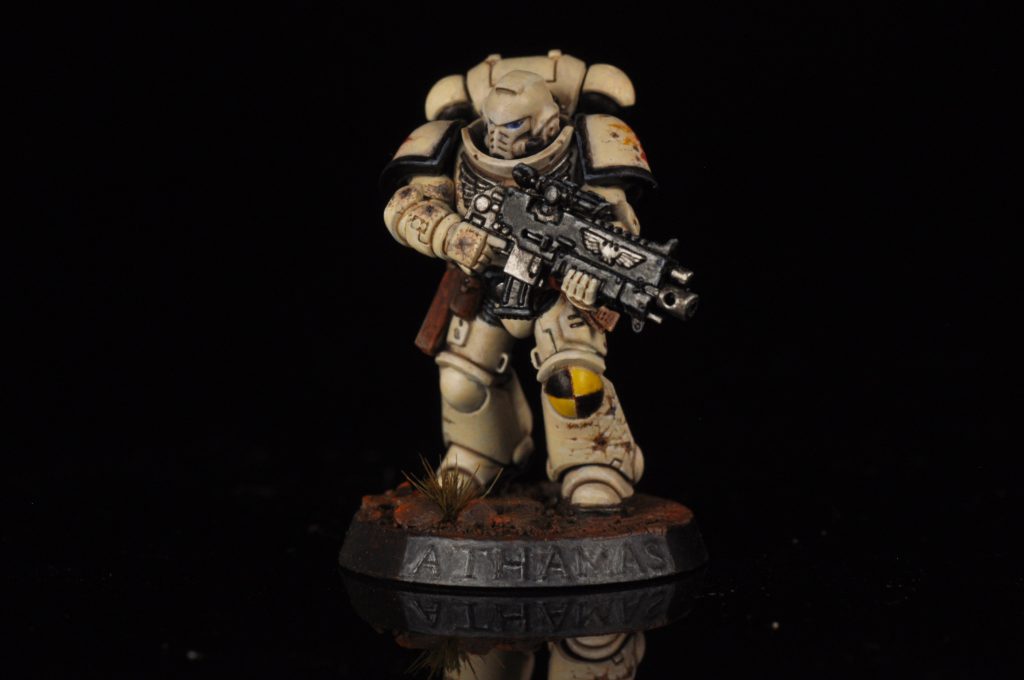
Equipment
There are some solid choices here, and you need to choose carefully based on what roles you are assigning your operatives.
Vengeance-Class Scope [3EP]
For a bolt rifle or stalker bolt rifle model, give them Lethal 5+. This helps out the standard bolt rifle a lot, and given that P1 and AP1 are the only difference between the two, always pick the bolt rifle (no heavy restriction, and if you get a single crit you are AP1 anyway). It’s one of several reasons I would not take stalker pattern bolt rifles. S
Reclusiam-Blessed Bolts [3EP]+ Limited to 1 per team
Pick a bolt weapon the operative has, add one to normal and critical damage. This makes bolt rifles and auto bolt rifles substantially better. This would be a nearly auto-take if it wasn’t limited to one per team, and is still great in the hands of an operative that may already have the Vengeance Scope. S
Tilting Shield [3EP]
Gives the operative the Tilting Shield ability, which means enemies can’t retain dice in combat as criticals unless they scored a 6, turning off Lethal 5/4+ and Rending, and similar abilities. This is great if your opponent has a lot of Rending or Lethal melee. This is a very niche choice, and is more useful if you’re running Assault Intercessors, otherwise avoiding combat is a great way to negate the lethal special rule… B
Purity Seal [3EP]
Once per battle Command re-roll Tactical Ploy for the model without spending CP. In effect you’re spending 3 EP for a command point, and that isn’t what I’d call a good trade. Hard Pass. D
Auspex [2EP]
The operative gains the Auspex Scan special action (1AP). Auspex Scan lets you select an enemy operative within 6” OR Visible, and that operative is not Obscured and cannot retain defense dice as a result of cover. This is great on operatives like the Gunner if they’re sat in a sniper nest and don’t need to move. You can’t use it if you’re within Engagement Range, but that’s a fairly obvious limitation. Really the main downside here is you’re paying EP for an item that should frankly be on one of the data-cards. B
Combat Blade [1EP]
Gives you +1 critical damage compared to Intercessor Fists. It’s a cheap upgrade given you are likely to end up with an EP left over after buying Auspex/bolt weapon upgrades. A
Frag Grenade [2EP]
It’s a Frag grenade, but as you’ve very likely already got the Grenadier you can’t take this option in a post-dataslate world. N/A
Krak Grenade [3EP]
See above. N/A
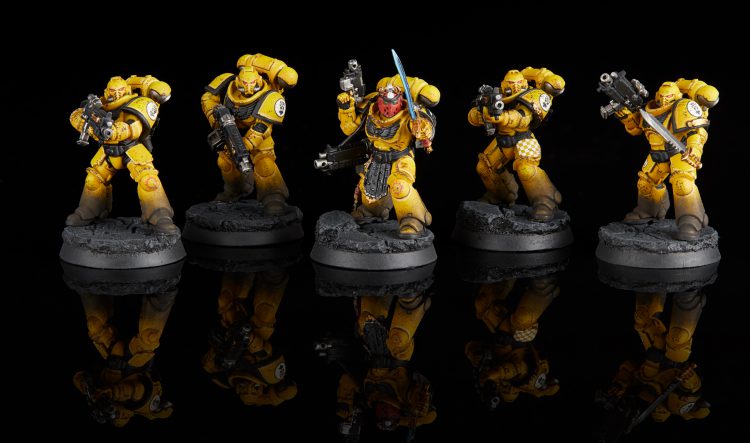
Tac Ops
With Security and Seek and Destroy as your archetypes you have a very solid choice of Tac Ops without using the faction-specific ones. Most of the time you will be using Seek and Destroy, specially Rob and Ransack and eliminate guards. If you fancy security (And I think it is suboptimal) you can always pick Seize ground, secure center line or central control.
Shock and Awe
Take an objective/s that was controlled by the enemy at the start of the Turning Point, and if you control it at the end score a VP. Do it during another Turning Point to score the second. B
This is a good Tac op to score since you are still playing to take the enemy objectives. It’s somehow winning more but still playing your game so take it with you since sometimes you will need this.
Champion of Mankind
When a friendly operative incapacitates an enemy operative, reveal this objective. At the end of the battle if this operative has incapacitated more enemy operatives than any of your other operatives, score a VP. If this operative has scored more than any of the enemy operatives, score a VP. S
This is crazy good, it is hard to deny it since you are a powerful-killy machine and you are under control on when to reveal it and who will be your champion.
Indomitable Superiority
Reveal at the end of the battle. If the enemy controls no objectives, but you do, score a VP. If you have more operatives than the enemy, score a VP. D
Really bad. Pass.
Updated Tac Ops
Intercessors have the Security and Seek and Destroy archetypes, and both of these are solid.
Executioner and Eliminate Guards are great for clearing objectives of enemy models, and pair well with Shock and Awe. Rob and Ransack is good for revealing when a model kills an enemy far away from the action, or even literally in the last action of the game using the Angel of Death ploy. Rout is good when you’re pushing into enemy territory and Headhunter is good to unpleasantly surprise your opponent since you only reveal it when you kill the enemy leader. Assassinate Target is a bit of a trap choice vs a horde faction like Guard as your opponent chooses the target and can just choose someone who never comes near your models and sits at the back either doing mission actions or objectives or just generally staying away from sharp objects.
Protect Assets and Central Control are good for missions where there is a central objective (though protect assets is a lot easier to score against a non-elite team because you have to kill two opponents). Hold Them Back is particularly useful in missions where models will have difficulty getting to the other side of the board before late game. Seize Ground combines well with Central Control, and Seize Access (the replacement for Seize Ground) similarly pairs well if there’s an access point next to the central objective or central point. Escort Operative is tricky, as you’re painting a target on one model from the second turning point onwards. Hold them back and Secure Centre Line pair well with aggressive play where you’re pushing forward and into enemy territory.
Intercessors benefit from having access to two tac op archetypes that pair well with their play style, and faction tac ops that pair well with them. It’s entirely possible to get a hand of tac ops that give you more VPs for kicking the enemy off the central objective and holding it, or just flat out murdering enemy models.

Playing Intercessors
With Intercessors your plan is often going to be to have a very conservative first turn where you don’t lose any models, or better yet you don’t take any damage. You want to score as much as you can in this first turn without losing models. During this first turning point you’ll want to do as many Move + Score + Dash rounds to get into heavy cover as you can. Abuse those 3 APL profiles to place yourself and score where you should.
Once the game moves into the second and third turning points it’s time for the marines to go “Brrrr” – shoot as much as you can and place as many operatives as you can in Engage orders to make them shoot. You want to overwhelm the enemy by having 4-5 operatives in Engage that will be able to shoot in Overwatch and if they die they’ll be able to perform the revenge shot. Your team is incredibly efficient on turns 2/3. Which doctrine you use here will depend on the map, but most of the time you’ll be using the Tactical Doctrine as you’ll be looking to take shots quickly against enemy operatives.
Turn 4 is the closing turn. Take the missing points from Guards or Rob and Ransack and complete your Champion of Mankind.
You can decide to have a quieter turn 2, but normally the game will not allow it (i.e. you’ll put yourself in a hole you can’t dig out of), and if you only place 1-2 operatives in engage the enemy will most likely be able to finish them off with focused fire. However if you have 3-4 in engage it will become much more complicated for your opponent to accomplish that.
Against hordes or mid-range teams any shooting activation is basically a kill so you want your shots to be as good as possible. Don’t be afraid to do Move+Dash+Shoot to put your operatives on the opponent’s half of the table and put pressure on them.
On the other hand against elites take good advantage of your plasma pistol – if you can place it in such a way that it can shoot with the revenge shot that’s ideal, so you can do double damage. Also take advantage of the auxiliary grenade launcher – your plan here is to start the job with grenades and then finish things off with assault intercessors.
Intercessors in the Gallowdark
In the Gallowdark the intercessors shine more than many other teams thanks to having 3APL and being able to shoot or fight twice. This makes them real killing machines, able to charge kill someone in a doorway and then perform a hatchway fight. On the other hand when carrying Methodical they are able to perform the Guard on a 3+ which is a huge improvement over their Phobos brothers and one of the main reasons to always carry this chapter tactic.
Intercessors sadly have no way to perform quest actions for free so gates can be a nuisance but with the new maps they are still able to move all over the place. My advice is that on the first turn you should open as many gates as necessary to ease the advance. Afterward with their high wound counts your team will be able to take a lot of damage before losing models. As always, it is still recommended that you play cautiously on the first turn, taking as many victory points as possible but not risking models to unleash hell on turn 2 and onwards.
What to Take?
A sample competitive roster:
- Assault Intercessor Sergeant – Plasma Pistol + Chainsword
- Assault Intercessor Sergeant – Hand Flamer and Power fist
- Assault Intercessor Sergeant – Hand Flamer and Power weapon
- Assault Intercessor Sergeant – Heavy Bolt pistol and Power fist
- Assault Intercessor Sergeant – Heavy Bolt pistol and Power weapon
- Intercessor Sergeant – Auto bolt rifle and power weapon
- Intercessor Sergeant – Auto bolt rifle and Power fist
- Intercessor Sergeant – Bolt rifle and Power weapon
- Intercessor Sergeant – Bolt rifle and Power fist
- Assault Intercessor Grenadier – Heavy bolt pistol + chainsword
- Intercessor Gunner – Bolt rifle + grenade launcher
- Intercessor Gunner – Auto bolt rifle + grenade launcher
- Assault Intercessor Warrior – Heavy bolt pistol + chainsword
- Assault Intercessor Warrior – Heavy bolt pistol + chainsword
- Assault Intercessor Warrior – Heavy bolt pistol + chainsword
- Assault Intercessor Warrior – Heavy bolt pistol + chainsword
- Intercessor – Auto bolt rifle
- Intercessor – Auto bolt rifle
- Intercessor – bolt rifle
- Intercessor – bolt rifle
For a competitive roster (like full on all options competitive) I would take the following. I know that’s a lot of Sergeants and only slight variations on the same thing, but it lets you adjust the models you choose to the enemy you face. However a competitive roster based entirely on a single sprue of Intercessors and a single sprue of assault intercessors is entirely practical and you don’t miss a lot of flexibility doing that.
I would think carefully about Chapter Tactics. You can put all your eggs in one basket, and Martial Zealotry has two good eggs in, Dueller and Aggressive, which makes it easy to parry a lot of your opponents hits and still be able to deal out a crit in terms of damage. But Dueller combined with Hardy makes you a lot more survivable in melee and taking shots, or Dueller and Stealthy if you are playing in a cover heavy environment.
My advice is largely to play some games and experiment. I play aggressively, but a standard intercessor team with Stealthy and Accurate is a lot of nice No Cover shooting especially against 5+ save enemies and with two retained cover saves when they shoot back has a lot of potential.
This is what I’d say would be a balanced team with a solid flexible roster with two notes to make a) Stalker bolt rifles are not good weapons if you want to move around the board and b) I don’t rate Thunder Hammers compared to Power Swords (more crits) or Power Fists (remove a wound 7 model on a single critical strike).
Kill Team for having fun
- Assault Intercessor Sergeant – Hand Flamer and Power fist
- Assault Intercessor Grenadier – Heavy bolt pistol + chainsword
- Intercessor Gunner – Auto bolt rifle + grenade launcher
- Assault Intercessor Warrior – Heavy bolt pistol + chainsword
- Assault Intercessor Warrior – Heavy bolt pistol + chainsword
- Intercessor – bolt rifle
This is what I’d build to use for games where I don’t have to be super serious and constantly try to make the optimal decision. It’s tilted towards melee, with two back field operatives for covering fire and four melee orientated operatives to move into the middle and take objectives. I’d take these guys Into the Dark, where a lot of short ranged guns and melee would do nicely thank you.
I would go pure Martial Zealotry as I’ll be taking these as Blood Angels with the Aggressive and Dueller traits, which would give me Rending if I charge, and if I parry with a crit, parry a critical and normal hit. This, combined with Assault Doctrine, let’s Assault Intercessors blender their way through anything roughly human sized taking not much more than chip damage in return.
For equipment I’d put a Vengeance-Class Scope, Reclusiam-Blessed Bolts and Combat Blade on the Bolt Rifle Intercessor, to give him lethal 5+ and 4/5 damage on his shooting and make him a bit nastier in melee, and an Auspex and Combat Blade on the Gunner to stop models hiding in cover from his grenade launcher. With 7 EP on one model it’s a lot, but it basically makes the Bolt Rifle a second support weapon with a damage output close to a heavy bolter.
Tooling up the shooting section means my opponent has to worry about it, while the melee section has both grenades and high damage output melee from stacking buffs before anyone even gets power fisted.
TheArmorOfContempt: Who cares about balance? While the operatives on my roster wouldn’t differ much from ThunderCloud’s, I am of the opinion that shooting and survival are the way to go for Space Marines. I would take Hardy and Accurate as my tactics along with the following as my primary team:
- Intercessor Sergeant equipped with Bolt Rifle and Power fist. Vengeance Class Scope and Reclusiam Blessed Bolts.
- Intercessor Gunner equipped with Bolt Rifle and Vengeance Class Scope
- Assault Intercessor Grenadier
- 3x Intercessor Warrior with Auto Bolt Rifles
Here your Sergeant can really become a ranged nightmare, who can stand behind your other operatives who you send forward to take fire and distract your opponent.
Alternatively, swap the Intercessor Sergeant out for an Assault Sergeant with a Chainsword/Plasma Pistol, and move the equipment over to a standard Intercessor Warrior. The Reclusiam Blessed Bolts are wasted on the Gunner simply because you want them on an operative that will be making two Shoot Actions per round with bolt weapons.
Painting and Collecting Space Marines
We’ve covered painting and collecting space marines before for Warhammer 40k and those same rules apply here. You can find guides for painting each chapter on our How to Paint Everything page.
Final Thoughts
Intercessors are a very good team to start developing as a competitive Kill Team player, good at shooting, good at fighting, tough as a rock, with mechanics to make them even more efficient and able to deal with any opponent. There are some teams that will not have an answer to deal with 6 models with 14 wounds and a vengeance shot.
They’re also a team that can be quite forgiving with mistakes and this makes them a very good faction for players who want to take their first steps into competitive play. From a cognitive load standpoint, there’s not a ton to worry about here, either – you don’t have to worry about auras or effects with fine measurement; just pick up that reliable bolter and put down the enemy operatives. This means you’ll often arrive fresh in the final rounds of an event and able to deal with things. Again, with bolters. But the bolter is more than enough for us, my brothers.
Have any questions or feedback? Drop us a note in the comments below or email us at contact@goonhammer.com.
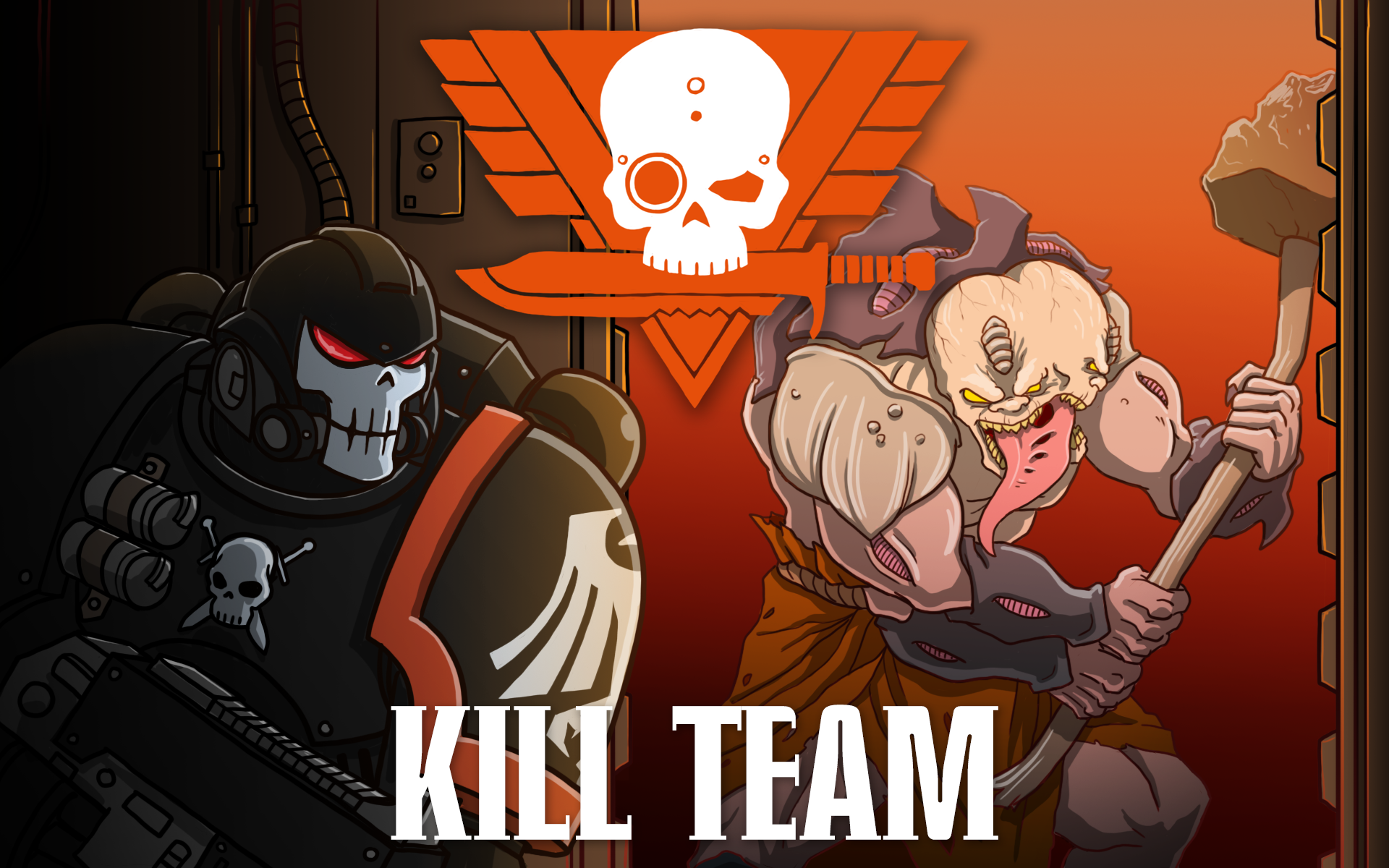


You must be logged in to post a comment.